Archive by Author
Arabic Number-gender Agreement and More Posted by Ibnulyemen اِبْنُ اليَمَن on Aug 16, 2018
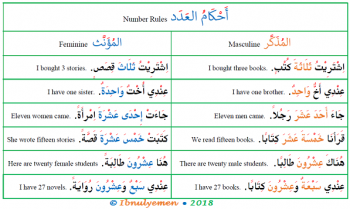
As stated in the previous post, the agreement between the gender of the noun and the number that qualifies it is confusingly difficult for native speakers and learners of Arabic alike. This is especially true with cardinal numbers الأَعْدَاد الأَصْلِيَّة. With other number types, the agreement is straightforward and always requires the addition of the…
Arabic Numbers: Cardinal, Ordinal, Fractions, and Percentage Posted by Ibnulyemen اِبْنُ اليَمَن on Aug 14, 2018
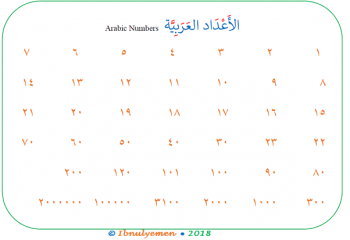
Arabic numbers الأَعْدَاد can be cardinal أَصْلِيَّة, ordinal تَرْتِيْبِيَّة, fractions كُسُور (plural of كَسْر), and percentage نِسْبَة مَئَوِيَّة. Ordinal numbers are the most difficult, even for native speakers of Arabic, because the gender-agreement with nouns they qualify is reverse. Cardinal numbers are straightforward as far as gender-agreement is concerned. This post presents lists of the…
Common Connecting Phrases in Arabic with Examples Posted by Ibnulyemen اِبْنُ اليَمَن on Aug 9, 2018
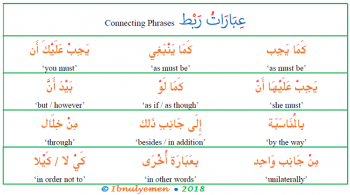
In Arabic, it is common to used prepositions حُرُوفُ الجَر and some particles الأَدَوَات when they are combine with other words as connecting phrase or linking words. In this post, you will learn some of these phrases. They are common in both spoken and written Arabic. العِبَارَة The Phrase English Meaning مِثَال Example (1) إِلَّا…
Active and Passive in Arabic: Practice and Examples Posted by Ibnulyemen اِبْنُ اليَمَن on Jul 31, 2018
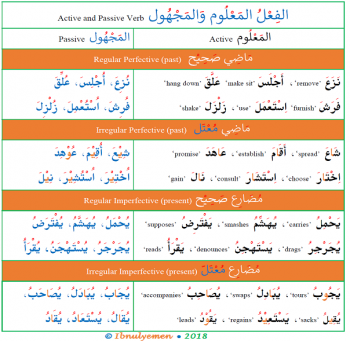
In the previous post, you learned about the passive voice المَبْنِي لِلْمَجْهُول in Arabic, and how an active مَعْلُوم sentence is changed into passive مَجْهُول. Besides leaving some words out from the active sentence, verbal internal (i.e. non-final) diacritical marks or short vowels must change. This is essentially the most obvious change in verb forms…
Changing an Active Sentence to Passive in Arabic Posted by Ibnulyemen اِبْنُ اليَمَن on Jul 24, 2018

To a change an Arabic sentence from active مَعْلُوم to passive مَجْهُول, its verb must be transitive مُتَعَدِّي. That is, it must have at least one object مَفْعُول. The sentence that includes an intransitive لَازِم or non-conjugatable جَامِد verbs cannot be changed into passive. This post is about why passive is used in Arabic, and…
The Gender of Arabic Nouns (2): Vocabulary and Examples Posted by Ibnulyemen اِبْنُ اليَمَن on Jul 19, 2018

In series one of this post, it was pointed out that the gender الجِنْس of noun in Arabic is not as straightforward as often thought of. You learned about different types of masculine المُذَكَّر and feminine المُؤَنَّث nouns as well as the feminine markers عَلَامَات التَّأْنِيْث. Today, you will learn about some irregularities of masculine…
The Gender of Arabic Nouns (1) Posted by Ibnulyemen اِبْنُ اليَمَن on Jul 17, 2018
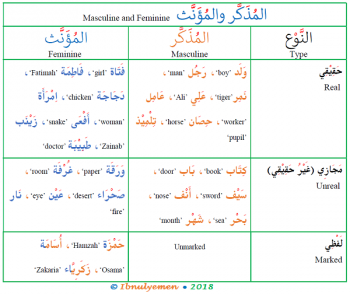
The gender الجِنْس of noun الاِسْم in Arabic is either masculine مُذَكَّر or feminine مُؤَّنَّث. The masculine المُذَكَّر is the basic form; therefore, it does not require a marker عَلاَمَة. The feminine المُؤَنَّث is derived from the masculine; it requires a feminine marker عَلَامَة تَأنِيْث. There are two types of masculine: real masculine and unreal…


